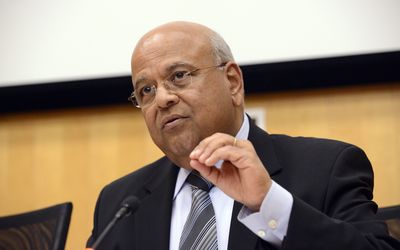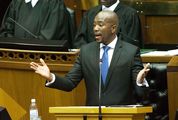THE Treasury has long had a policy of updating its economic forecasts just twice a year — in the finance minister’s February main budget and the October medium-term budget.
So when Finance Minister Pravin Gordhan says the Treasury has maintained its 2.7% growth forecast for this year — as he did in Washington this week — one should not necessarily assume his team still believes it.
Certainly nobody else does at this stage. True, much could happen between now and October. And the finance minister has to try to talk up the economy, as far as he can, so Mr Gordhan is doing that. The global environment is looking more stable, he says, and that’s good news for South Africa and other emerging markets.
But the trouble is that South Africa’s own woes mean that it will not benefit as it should from the global recovery.
The list of woes is long, there are no easy solutions to most of them, and domestically, good economic news is hard to find.
The International Monetary Fund (IMF) in its World Economic Outlook report last week downgraded its economic growth forecast for South Africa to 2.3% for this year, from its 2.8% call in January. Next year’s forecast has been cut to 2.7% from 3.3%, and the risks, as the IMF’s economists see it, are to the downside. In other words, chances are the outcome could be even lower.
The IMF cited industrial unrest and policy uncertainty as risks to growth. And its forecasts are starting to look relatively upbeat compared to the even gloomier outlooks of some private sector economists, who are revising their growth projections for this year down to the 2% or even 1.8% level.
Economists have been looking again at the numbers after a particularly disappointing set of manufacturing and mining output figures last week.
Mining output contracted at 7% in February, bringing the annual decline in the sector to almost 5%. Manufacturing production contracted too over the month, with the annual number now down 1.4%. That is likely to mean that growth for the first quarter will come in below expectations, and the year as a whole could go the same way.
The crippling platinum industry strike is just one factor, and there is no clear end to that one for now. Hugely constrained electricity supply is another factor which has had a significant effect on manufacturing and mining output, and indeed on investor confidence. There is no near-term solution to the electricity constraint either.
Economists cite additional risk factors, such as the cutting of household debt and the slowdown in the consumer spending that had been a key driver of economic growth.
Worth noting too is that the slowdown in growth could put the squeeze on the fiscus, if revenue from sources such as value added tax comes in below budget and the deficit ratio comes out higher because gross domestic product is lower than expected. That would make it more difficult to continue the fiscal stimulus that has helped to smooth the economy.
The IMF is, as usual, calling for countries such as ours to undertake structural reforms to remove constraints and speed up the pace of growth. That is clearly crucial to ensure higher and more sustained rates of growth in the medium to long term. But in the short term there are urgent issues to address if South Africa is to hit even a below-par growth rate of about 2% for this year.
A way out of the platinum strikes must be sought, urgently, and leadership from all sides brought to bear. Some creative thinking must be brought to bear as well on the electricity supply shortage and sensible solutions negotiated and implemented which can contain the damage over the next year or two.
Unfortunately, election time tends to put problems on hold while leaders busy themselves on the campaign trail. South Africa cannot afford for that to happen now.

Finance Minister Pravin Gordhan. Picture: ARNOLD PRONTO
THE Treasury has long had a policy of updating its economic forecasts just twice a year — in the finance minister’s February main budget and the October medium-term budget.
So when Finance Minister Pravin Gordhan says the Treasury has maintained its 2.7% growth forecast for this year — as he did in Washington this week — one should not necessarily assume his team still believes it.
Certainly nobody else does at this stage. True, much could happen between now and October. And the finance minister has to try to talk up the economy, as far as he can, so Mr Gordhan is doing that. The global environment is looking more stable, he says, and that’s good news for South Africa and other emerging markets.
But the trouble is that South Africa’s own woes mean that it will not benefit as it should from the global recovery.
The list of woes is long, there are no easy solutions to most of them, and domestically, good economic news is hard to find.
The International Monetary Fund (IMF) in its World Economic Outlook report last week downgraded its economic growth forecast for South Africa to 2.3% for this year, from its 2.8% call in January. Next year’s forecast has been cut to 2.7% from 3.3%, and the risks, as the IMF’s economists see it, are to the downside. In other words, chances are the outcome could be even lower.
The IMF cited industrial unrest and policy uncertainty as risks to growth. And its forecasts are starting to look relatively upbeat compared to the even gloomier outlooks of some private sector economists, who are revising their growth projections for this year down to the 2% or even 1.8% level.
Economists have been looking again at the numbers after a particularly disappointing set of manufacturing and mining output figures last week.
Mining output contracted at 7% in February, bringing the annual decline in the sector to almost 5%. Manufacturing production contracted too over the month, with the annual number now down 1.4%. That is likely to mean that growth for the first quarter will come in below expectations, and the year as a whole could go the same way.
The crippling platinum industry strike is just one factor, and there is no clear end to that one for now. Hugely constrained electricity supply is another factor which has had a significant effect on manufacturing and mining output, and indeed on investor confidence. There is no near-term solution to the electricity constraint either.
Economists cite additional risk factors, such as the cutting of household debt and the slowdown in the consumer spending that had been a key driver of economic growth.
Worth noting too is that the slowdown in growth could put the squeeze on the fiscus, if revenue from sources such as value added tax comes in below budget and the deficit ratio comes out higher because gross domestic product is lower than expected. That would make it more difficult to continue the fiscal stimulus that has helped to smooth the economy.
The IMF is, as usual, calling for countries such as ours to undertake structural reforms to remove constraints and speed up the pace of growth. That is clearly crucial to ensure higher and more sustained rates of growth in the medium to long term. But in the short term there are urgent issues to address if South Africa is to hit even a below-par growth rate of about 2% for this year.
A way out of the platinum strikes must be sought, urgently, and leadership from all sides brought to bear. Some creative thinking must be brought to bear as well on the electricity supply shortage and sensible solutions negotiated and implemented which can contain the damage over the next year or two.
Unfortunately, election time tends to put problems on hold while leaders busy themselves on the campaign trail. South Africa cannot afford for that to happen now.




















Change: -0.47%
Change: -0.57%
Change: -1.76%
Change: -0.34%
Change: 0.02%
Data supplied by Profile Data
Change: -1.49%
Change: -0.01%
Change: -0.47%
Change: 0.00%
Change: -0.08%
Data supplied by Profile Data
Change: 0.36%
Change: 0.84%
Change: 0.22%
Change: -0.22%
Change: 0.82%
Data supplied by Profile Data
Change: 0.28%
Change: -0.53%
Change: 0.20%
Change: -1.40%
Change: -1.88%
Data supplied by Profile Data